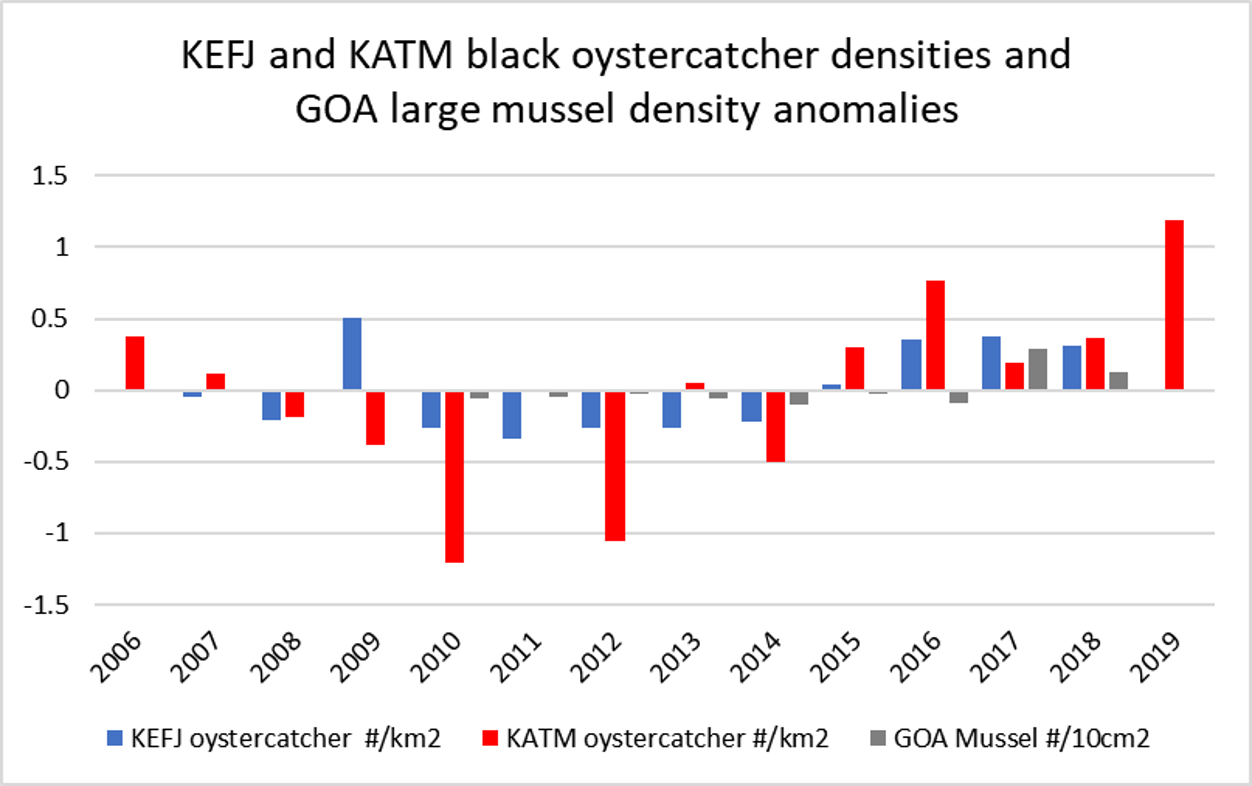2Why are we monitoring?
The black oystercatcher is a conspicuous member of rocky intertidal marine communities in the north Pacific. Black oystercatchers are completely dependent on nearshore marine habitats for all critical parts of their life cycle including foraging, breeding, chick-rearing, and resting. As such, they are useful indicators of nearshore ecosystem health and therefore particularly amenable to long-term monitoring. However, this same reliance on coastal ecosystems makes the black oystercatcher highly susceptible to human disturbance and other forms of nearshore habitat change. The black oystercatcher is considered a Management Indicator Species by the Chugach National Forest and a species of concern by the Alaska Shorebird Working Group.
We monitor several aspects of black oystercatcher populations, including diet through collection of prey remains brought back to the nests to feed the chicks, nest density, nesting phenology, nest productivity, nest density, and overall density.
Where are we monitoring?
We monitor black oystercatchers across a broad swath of the northern Gulf of Alaska within the area affected by the Exxon Valdez oil spill. Study regions include western Prince William Sound (WPWS), Kenai Fjords National Park (KEFJ), Kachemak Bay (KBAY), and Katmai National Park and Preserve (KATM).
How are we sampling?
There are five different ways black oystercatcher data are collected:
-
- Black oystercatcher specific boat-based nearshore surveys to estimate nest density and distribution. These surveys are conducted in early summer.
- Once a nest is located, the area is searched on foot to determine nest productivity (the number of eggs and chicks per nest).
- During the same nest search, if chicks are present, prey remains are collected (food brought back to the nest to feed the chicks) to determine species composition and size distribution.
- If eggs are present during the nest search, they are floated in fresh water to determine the stage of embryo development and estimate the hatch date.
- Marine bird and mammal boat-based nearshore surveys to estimate overall density and distribution for a variety of species, including black oystercatchers (see Marine Birds).
What are we finding?
Black Oystercatcher Nest Density
Black oystercatcher nest density appears to be highly variable within a region across time. However, KATM tends to have the highest nest density of black oystercatchers while KBAY supports the lowest within our study region.

Black oystercatcher nest density estimates across all four Gulf Watch Alaska regions: Katmai National Park and Preserve (KATM), Kachemak Bay (KBAY), Kenai Fjords National Park (KEFJ), and western Prince William Sound (WPWS). Error bars indicate ±1SE
Black Oystercatcher Chick Diet
In terms of prey, chick diet has been found to be dominated by three species of limpets (Lottia spp.; up to 67% of diet), followed by mussels (22%). We did not find significant variation in the diet by year or across regions.

Species composition of prey remains collected at black oystercatcher nests across all four Gulf Watch Alaska regions: Katmai National Park and Preserve (KATM), Kachemak Bay (KBAY), Kenai Fjords National Park (KEFJ), and western Prince William Sound (WPWS).
Black Oystercatcher Density and Mussel Abundance
In contrast, the abundance of all black oystercatchers (except chicks) at KATM and KEFJ from marine bird and mammal surveys (see Marine Birds) have a positive relationship with that of large mussel abundance, which means that in years when large mussel abundance was above normal (see Bivalves), black oystercatcher densities were also higher than average.




